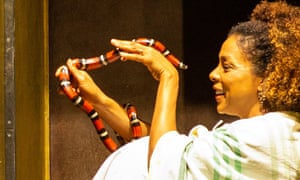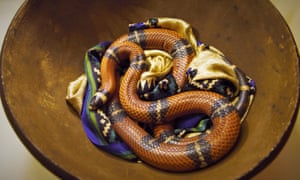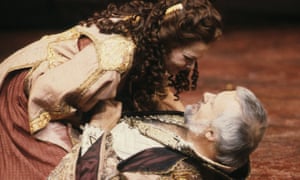Love and hisses: Cleopatra star Sophie Okonedo on acting with live snakes
The actor, who is performing in Shakespeare’s tragedy on the Olivier stage, is to make her National Theatre Live debut with one of her real reptile co-stars
When the National Theatre’s Antony and Cleopatra is broadcast to cinemas in December, Ralph Fiennes and Sophie Okonedo won’t be the only stars getting ready for their close-up. Fiennes is no stranger to NT Live screenings but Okonedo will be making her debut, as will one of four real snakes used in the production.
It has not yet been decided which of the snakes, which are used in rotation throughout the play’s run, will appear in the broadcast. It could be Pork Pie, Hondo, Little J or Larry, who had no name when he arrived for the show but has been christened in honour of the National’s first artistic director and the Olivier stage on which he appears.
Okonedo, who has never worked with animals in the theatre before, said she and director Simon Godwin “felt very strongly before we started rehearsals that it would be a bit of a letdown if we brought out a rubber snake at the end of the show”. When she first handled snakes, she was surprised to find them “the most beautiful and fascinating creatures”.
The snakes are owned by Mark Amey, who specialises in animal handling for film and television. Using his animals in rotation gives them time to rest in between performances. Amey says he is impressed by Okonedo’s multitasking. “She’s got to remember her lines and she’s also got to be a professional snake wrangler. She’s got to get the snake’s head at the right position at the same time as delivering the line at the right point. It’s a big ask.”
The reptiles are all milk snakes, a type of constrictor. They measure one metre long and were chosen for their dramatic colours. Pork Pie was a rescue snake who was rather obese, but the exercise of performing in the show has helped him lose weight. Another of Amey’s snakes, Mr Jangles, was removed from the production because he is “quite fidgety”. He is one of Amey’s most successful snakes on film but theatre work doesn’t suit a snake who likes to “do his own thing”. Hence the casting of Little J.
Four backstage snake carers work on the production. The animals have their own green room at the National: a vivarium, which is a wooden unit with sliding glass doors, controlled lighting and heating, complete with branches for the snakes to climb.
Snakes, says Amey, “are very intuitive to how we feel. If we’re tense or stressed then they become stressed. If you relax and wind down, the snakes wind down.” Okonedo says “I adore all four of the snakes” and that they have become an integral part of her nightly warm-up. “I do lots of humming exercises, which seems to put them in a sort of stupor as they lay across my chest, which is relaxing for me and them, I guess.”
This is not the first time that real snakes have been used for Shakespeare’s tragedy at the National: Judi Dench shared scenes with a snake in a 1987 production co-starring Anthony Hopkins. In the play, an asp is used by the Egyptian queen to kill herself; she places it on her breast and tells the “poor venomous fool” to “be angry”.
The snakes are not the only animals to have taken centre-stage in London in recent years. The Almeida’s production of Ibsen’s The Wild Duck briefly features a real fowl and Jez Butterworth’s The Ferryman – now on Broadway after a successful London run – has a sensational scene with a goose. At the start of its preview period, Harry Potter and the Cursed Child used live owls, but then removed them from the production. The animal rights organisation Peta applauded that decision, saying: “The West End offers many innovative stage productions such as War Horse and The Lion King that create breathtaking effects without exploiting animals.”
- Antony and Cleopatra will be broadcast live to cinemas across the UK and internationally on 6 December as part of National Theatre Live
Since you’re here…
… we have a small favour to ask. More people are reading and supporting The Guardian’s independent, investigative








No comments:
Post a Comment